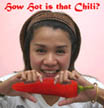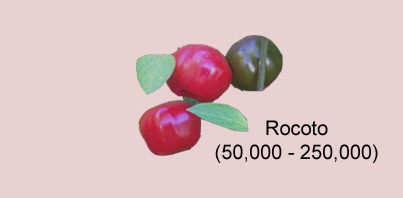 |  |  |
 |  |  |
| Rocoto
was the most abundantly available chili in the Inca empire where it was
known as rocot uchu “broad chili”, and together with kellu uchu (C.
baccatum) and the potent chinchi uchu (C. chinense), it was the
dominant flavouring in Incan cooking; in fact, the Incas hardly used
any other flavourings. Today, the Capsicum pubescens chili is generally termed rocoto and locoto in Perú and Bolivia, respectively, and chili manzano (“apple chile”) in México. The cultivar with yellow fruits is known as chile canario. The species has been put to cultivation in the highlands of Perú and Bolivia, and even today, cultivation outside that region is rare. It has been introduced to the tropical mountains in Central America (México, Honduras), and very recently cultivation started in Java/Indonesia as a pilot project. The C. pubescens cultivars can easily be identified by their purple flowers, hairy (pubescent) leaves and quite large apple-, pear- or egg-shaped pods with dark, almost black, seeds. Black seeds are a unique feature of C. pubescens, not shared by any other wild or cultivated species. For the cook, the rocoto is characterized by thick-fleshed pods unsuited for drying, a specific flavour, and widely varying hotness (50,000 to 250,000 Shu's on the Scoville scale). There is considerable disagreement about the actual hotness of the rocoto. In addition to the usual variations due to climate and soil, there are probably also individual differences: Because of its unusual spectrum of capsaicinoids, some humans find rocotos extremely hot, even hotter than habaneros, while the majority would rate them only moderately hot. | |||||||||||||||||||
|  | ||||||||||||||||||